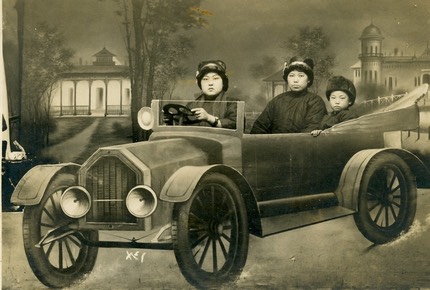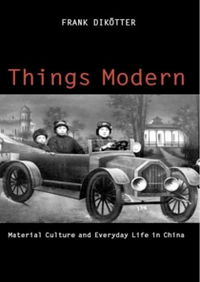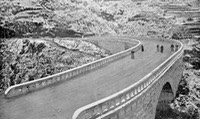Highway to Heaven
'From one end of the Chinese Empire to the other there is not an instance of a road whose quality would be termed in any other country as even moderately good. China's rivers and waterways are her highways, and it is on them that she relies for means of internal communication.' Thus wrote W. Barclay Parsons, an American engineer, with some exaggeration in 1900. Even the roads leading to the imperial capital were full of ruts, stones, boulders, open cesspools and pits with dark mud. Whether in the north or the south, streets outside traditional cities were rarely paved, often consisting of loose dust when dry, turning into mud after a little rainfall; bullock carts and wheelbarrows would lurch along in the sludge during the rainy season. Throughout the northern plains, cart ruts could reach the axle, and a deep road could become the bed of a stream after heavy rain. As farmers sometimes dug in roads to restore the soil to the fields which had been washed away, major thoroughfares could become mere ditches and gullies. Dust was a widespread nuisance for travellers on barrows, carts, mules, donkeys and camels - all traditional means of transportation. Victor Purcell thus complained about the 'glutinous, adhesive red dust' in Hunan which seared the eyes, clotted the throat and caked the hands. Even in large cities like Beijing mule carts without any suspension ploughed through the dust at walking pace, and a trip across the capital could easily take up an entire day. The situation was only slightly better in the foreign concessions: even in Shanghai in the 1910s the streets were paved with a mixture of broken stones and clay; they were kept in order by tamping in the broken stone and then filling the crevices with clay. Once the mud had dried, a roller would be used to smoothe the surface, until the next rainy season would wash out the clay and the road had to be repaired again.
The first macadamised road in the capital was constructed from Xizhimen to the Summer Palace for the convenience of officials on their way to court audiences. The road followed an old stone thoroughfare which had existed for centuries, and parts of the original pavement were left on purpose for heavy springless carts. The destruction caused by the Boxer rebellion precipitated an official move towards the construction of modern roads: some of the walls in the capital were torn down in 1903, the bricks being used to fill the moat, while a wide boulevard with a tramway was built on the site of wall and moat. Tianjin, occupied by foreign powers after the Boxer rebellion, had the remains of bombarded walls and gateways removed for making roads and furnishing ballast for railway construction; the open spaces where the walls stood were turned into public thoroughfares, planted with trees and lit by electricity. While the destruction of city walls in Beijing and Tianjin was a penalty imposed by foreign powers after the Boxer rebellion, other cities enthusiastically rushed to follow this early example, Shanghai and Canton in particular. Canton, for instance, ruthlessly tore down its walls in 1919, coolies carrying away every blue-grey brick from the 8-metre-high wall and its many gates. Wide avenues appeared instead, the first section of the wall giving way to a street 25 metres wide. Other roads followed, the demolished walls providing material for paving the streets, its bricks and stones leading to a circular motorway. Over the following decade several dozen kilometres of asphalt, concrete and macadam roads were laid, road construction reaching a peak after mayor Liu Jiwen assumed office in 1932. The streets soon resounded to the honking of Fords.
Nanjing went further: in a fantasy of industrial modernity, a technocratic elite even envisaged that the ring road would be put on top of the old city wall, although this plan was abandoned for a more pragmatic approach. Zhongshan Road was the new capital's first road, part of a network of highways which were up to forty metres wide. New roads - in Nanjing but also elsewhere - had five sections which consisted of a centre lane for fast traffic, two roadways for slow-moving vehicles and two wide pavements. As the traffic in the new capital increased drastically with the provision of a modern road system, police were no longer sufficient to regulate traffic, and traffic signs with red and green lights were erected on the main thoroughfares. Cities which gleefully destroyed their walls - symbols of closure in a bygone era - stood increasingly in sharp contrast with the lonely towns which were still girdled by walls, aged, and dreaming of the past: their crenellated parapets, overgrown with vines and shrubbery, erstwhile symbols of imperial grandeur, were now seen as indicating backwardness.
By the end of the 1920s reports from all over the country told of new roads being energetically and enthusiastically built, 'roads which are levelling the walls and entirely changing the face of old Chinese cities, roads running along the banks of rivers, winding in and out of villages, even climbing over mountain passes.' Many were metalled and drained, even more just bad or merely indifferent, some with a surface of mere earth which became impassable in rainy weather. However, the quality of the soil could vary greatly: for instance, the sandy earth used in parts of Sichuan contributed to a relatively reliable surface. Irrigation ditches on the road out of Chengdu, on the other hand, meant that passengers had to dismount every few hundred yards while two planks were used to bridge the ditch. After rain, traffic rarely waited for the soil surface to dry; the result was that many roads were cut up into ruts of varying depth and width, putting a great strain on springs and passengers. On roads which suffered from poor drainage, traffic was generally suspended in the summer as rain turned them into a quagmire. In some cases the use of modern roads was forbidden to barrows and carts which cut into their surface. Some provinces, Hunan being an example, had examination stations every 25 miles: the halts were compulsory and petrol was available.
The result of these various efforts was that 75,000 km. of roads passable for cars existed in China by 1935, a figure which increased to some 176,000 km. in 1937. Even if less than a quarter had been surfaced with untreated macadam or gravel, the results were generally judged impressive. Lady Hosie remembered how just after the 1911 revolution the fifteen-mile mud-track from Taiyuan to a temple outside the city took seven hours to cover on horseback, the animals frequently wading through thick grey mud. In 1937, in contrast, the journey took forty-five minutes on a good road and over a bridge with iron girders. Emil Fischer was also taken aback by the wide streets and automobile roads which had appeared in Kunming since the 1911 revolution. Writing in the 1930s, William Sewell was startled by the rapid changes which were taking place, as hundreds of cars and lorries were imported, rickshaws, bicycles and cars replaced wheelbarrows, sedan chairs and rumbling wooden carts, while even the camel caravans of northern deserts were threatened by tractors with caterpillar wheels. Cities were being entirely rebuilt, new two-storied shops springing up in place of old and dirty hovels: 'Crooked and narrow ways and winding, evil-smelling alleys are swallowed up in the fine straight roads, so that a traveller returning after a few months' absence can scarcely find his home.' Victor Purcell, keen observer of local life and experienced traveller, expressed his astonishment at the 'remarkable achievement' of the road system, which had been virtually non-existent in the 1920s; even relatively remote cities like Nanning, Liuzhou and Guilin in Guangxi province had wide concrete streets lined with trees.

Roads, like railways and waterways, released labour, increased mobility and intensified a network linking the hinterland to the global economy. But they were experienced in contradictory ways by residents, all the more as most new roads were built by local government on land confiscated from farmers without compensation. Compensation could be offered in cities: in Wuxi, for instance, money was given for each square metre destroyed to make way for the new ring road in the case of solid houses, while owners of straw huts received nothing at all. Road-planning, moreover, was often carried out with little concession to topography; graves were uprooted, houses flattened, walls destroyed. In Canton, bands of labourers could be seen working on new roads in the mid-1920s, while private property was demolished for roads and parks without apparent compensation. Already in the nineteenth century several of Canton's city gates and nearby residences had been razed in order to build roads for horse carriages, 'many old ladies and young children being driven to tears'. In Yangzhou after 1911 some locals resented the construction of new roads: 'one can no longer see flowers', although modern transportation was also believed to bring prosperity. A great number of residential houses near the new throughways of Nanjing were also flattened after being purchased by a land acquisition committee. Evicted people were given priority housing in new residences near the Drum Tower and outside Wuding Gate in the south of the city, although in 1929 the mayor acknowledged discontent with city planning and the dissatisfaction of some at the destruction of houses in the making of Zhongshan Road; in his opinion it was 'a matter of sacrificing the minority for the majority'. In Kunming no less than 2,000 houses were pulled down for road expansion in 1935 alone, while in Hankou the city walls were knocked down in 1907 for a new road, one bamboo verse lamenting the disappearance of old houses. Massive opposition from local residents in Changsha, however, led the local government to modify its radical plans for a high street cutting through popular districts.
Yet not all reactions were negative: within months of the completion of Suzhou's first road in 1896, built by the imperial government to foster local development, it became a major leisure destination for local people. A year later splendid fašades in modern style were erected on buildings in order to increase business, while the street became a 'showcase for imported transport and industrial technology'. New roads were ideal for the social promenade in which new items carried on the person could be shown off, from leather shoes to panama hats, unimpeded by water, mud or dust. A playground for the wealthy, a social site of leisure, the paved street or cobbled square was regularly paced in a ritual of conspicuous display; electricity would permit the evening stroll. Nor was the promenade reserved for elites: the Bund in Shanghai, it was observed by a disgruntled foreigner in 1925, was used by a stream of locals promenading by the water, some 'of the dirtiest class', walking on the grass plots and sitting on the seats, including those marked 'reserved for foreigners only'.

